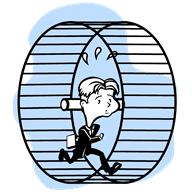Entries Tagged 'social media' ↓
January 18th, 2013 — Customer service, social media, social media marketing, social networking, twitter
If you’re going to use social media as part of your marketing strategy, you’ll need to know how your consumers are using it to make sure you’re getting the right type of information to the right people.
As more and more people start to dabble in the ‘social side’, the marketing landscape begins to change. People want to get their information in different ways, they want to connect with companies directly and quickly and how they access social media is also changing.
A recent report by Nielsen and McKinsey, called Social Media Report, looks at the survey results of consumers to discover how they use social networks.
Mobile time is increasing
With the rising number of smartphone users, it’s hardly surprising that the report found consumers are increasingly using their smartphones and tablets to access social media.
The main device used is still the PC, 43% of users said they used smartphones to access social media, with 16% using a tablet.
That would therefore suggest that as marketers, you should be investing in your mobile content. That means a mobile website, using social media and perhaps even getting your own app.
Pinterest rises
As a copywriter, Pinterest is something that I still haven’t really got to grips with. But perhaps that should now change as the report showed that it had not only the highest increase in audience, but also the largest amount of time spent on any social network across all devices.
Of course, simply having an interesting display of great items on Pinterest isn’t going to do you any good unless you actually engage with other ‘pinners’.
Feel good feeling
One of the most surprising findings is that 76% of social media users said they experienced positive feelings after using it. The felt informed, excited and connected.
Of course, you’re not going to please everyone all of the time.
Social TV and Twitter
Twitter was also discovered to be the most powerful driver of ‘social TV’ – that means that it’s the one platform people (usually adults aged between 35-44) use to share their views and opinions about what they’re watching (e.g. sports events, Elections etc.).
The report goes on to say that in June 2012, one third of active Twitter users tweeted about TV content, up from 26% from the beginning of the year.
Customer service through social media
The report showed that 1 in 3 social media users prefer is receive customer service through social media platforms as opposed to contacting the company by phone.
Of course, for marketers that means that consumers are used to receiving instant feedback and in fact expect it, so it’s important that your use of social media allows you to respond quickly.
The emergence of the social advert
What do you think about the social adverts you see on Facebook etc.? Well, apparently 33% find them annoying, but surprisingly 26% of those surveyed said they were more likely to pay attention to an advert posted by a friend.
Perhaps you should give some extra thought to your social advertising plan.
The social buying decision
The growing use of social media is changing the way people shop. Today, consumers use their social media channels to learn about other peoples’ experiences (70%) and information about a brand’s products or services (65%).
So, you really need to think about your brand image and how you come across as a company.
Over to you
How do you feel about using social media today?
Did any findings in the report surprise you?
Leave comment and tell us what you think.
January 14th, 2013 — social media, social media marketing
Social media marketing is something that most businesses are using to promote their brand and raise awareness.
I say most because there are still some that shy away because they either don’t know how use it effectively, believe their results can’t be monitored or have dabbled but been disappointed with the results.
The ability to measure your social media performance is the only way you can hone what you’re doing to achieve the results you want.
A recent post on Social Media Examiner caught my eye as it talks about 3 analytic tools you can use to help improve your performance in the social media arena.
This is the first of the tools that they talk about.
Through it you can set up alerts based on keywords, then content related to those keywords is shown through the Mention application or sent to you by email or social media.
This helps you find potential business, build and enhance relationships and respond quickly to situations that could potentially damage your brand.
The Social Media Examiner post goes into more details about how it works and how to set it up (link at the end of this post).
This simple, free tool will help you assess your Facebook Page and give suggestions about how you can improve it. Unlike the analytics provided by Facebook, LikeAlyzer is not complicated is use and can give you some very valuable insights.
In a nut shell, it looks at your Page and assesses how well it performs in relation to other Pages, grading it from 0 – 100 (higher is better).
Then it makes suggestions about how you can improve your Page based on this analysis.
Again, further details about how you can set this tool up are given by Social Media Examiner.
Another free tool, this one analyses how popular or unpopular content is on a website and can be very handy when you want to check out the performance of your or your competitor’s blog.
By analysing the content, it gives you a detailed report on where content is shared and how often.
Once you find out the most popular type of content you can generate more of the same, but it’s a good idea to do this regularly as your audience’s tastes may change over time.
These 3 tools will help you improve your social media performance, so for more information about how to set them up and use them, head over to Social Media Examiner today.
January 2nd, 2013 — blogging, blogging for business, marketing, online marketing, social media, Social media policy
This is it.
The New Year is almost upon you, so it’s time to take stock and stop kidding yourself.
You’ve been working like a Trojan all year and your marketing efforts are starting to pay off. But because your activities have been pulling in more customers, your workload has increased making keeping up with the marketing really difficult.
Every week it’s the same; day after day you’re the one working late desperately trying to get all those blogs scheduled and articles written. You’re the one eating lunch at your desk as you try to keep up with your Twitter feed and Facebook comments.
Why?
Because either
- You are the business owner and don’t trust anyone else to do it, or
- You’re the only one daft enough to have shown a bit of gumption about content marketing and social media and knew enough about it to give it a go
Well now’s the time to stop – get off that eternal hamster wheel.
You have a perfectly good team around you, so it’s about time they started pulling their weight too.
Marketing a business has to be a team effort, so don’t be put off by their ‘but I won’t know what to say’, or ‘what shall I write about?’ excuses – if you can do it, so can they.
Yes, it’s time to delegate.
Blogging
The most common reason not to blog is not knowing what to write about.
Tosh – for a start, anyone in your company that deals with customers should have a shed load of stuff to write about. Just think about all those queries and questions that come their way – instant ‘how to’ guides.
What about all the advice they offer – perfect ‘top tips’ material?
How about issues customers have and the way you, as a company, resolve them – ideal case study material.
See, there’s no excuse – everyone in your team should be contributing at least one article a week.
Social media
Before you delegate your social media activities, make sure you have a social media policy in place so everyone knows how they should react to comments, what they can and can’t say etc.
Then you just need someone to monitor your Twitter and Facebook accounts so that all comments are responded to in a timely manner.
But make sure they understand the importance of building relationships and that they engage with your followers and fans; providing a stream of interesting and relevant tweets and status updates will boost your company’s visibility.
By the way, if you think by delegating all this stuff you can take the year off, sorry, it doesn’t work like that.
All this regular activity is going to be driving more business your way, leaving you to do what you do best – sell.
Remember, no one is Superman or Wonder Woman – by spreading the workload you’ll achieve your goals much faster, you’ll be less grey, far calmer and will also get to enjoy lunch away from you desk.
Sally Ormond – overworked professional copywriter, blogger and social media addict
November 19th, 2012 — copywriter, copywriting, copywriting tips, social media, social media marketing
Ask any professional copywriter and they’ll tell you it’s much harder to write short copy than long.
It’s much more difficult to get your message across when you only have a few characters to play with. That’s why social media copywriting is so tough and why so many people get it wrong.
How many times have you seen a random Tweet that’s full of abbreviations that makes no sense whatsoever? What about Facebook updates that ramble on and on?
In this post, I want to look at how to write effective social media updates that have meaning.
Twitter
Twitter is probably one of the hardest platforms to write for, purely because you only have 140 characters to play with.
As I mentioned above, the temptation is to squeeze as many abbreviations in as possible to ‘cheat’ the character limit.
But that usually ends up in a bizarre tweet that few people will bother looking at.
Writing short copy is difficult, but also a great way of honing your writing skills. After all, with only 140 characters to play with it’s essential that every word you use counts.
You can tighten your message by cutting out unnecessary adjectives (something that will also help your general sales writing) and by getting to the point straightaway.
Keep your tweet to one topic and remember to add a link if you want to direct people to an article or web page that backs up your tweet.
Keeping your updates short like this will also help your followers. If they like what you say and want to retweet it, by keeping your character count down they should be able to do so without having to go in and edit it down.
Facebook
Although Facebook gives you far more room for your updates, it is still good practice to keep them punchy and to the point.
If you post rambling updates no one is going to want to read them, so keep them short, relevant and interesting.
Also, if you want to raise your reach on Facebook ask for comments and reactions. The more reactions your post gets, the more newsworthy it becomes, which will increase its appearance in news feeds.
By adding video, polls and images you can increase your level of engagement, but what’s also important is to remember to post when your followers are likely to be online. The scheduling tool is perfect for this.
LinkedIn
LinkedIn is more about business and less about personal interaction. It is a platform from which you can show your expert status within your field. That means comments about needing a coffee, what you had for lunch etc., are not really going to be all that effective.
For LinkedIn look at posting news stories that are relevant to your industry and add your comments and opinions. This will encourage others to do the same and get a conversation started.
It’s also a great place to share news about your company, whether you’re hiring new people, starting a new exciting project or diversifying.
This social media platform opens up the opportunity for longer updates, but again they must be relevant and interesting.
As you can see, social media copywriting can be a complex animal, but it is also a great way to practice your short copy skills.
October 10th, 2012 — social media, social media marketing, social networking, twitter
We all love Twitter – go on admit it, even you’ve fallen in love with it.
It’s such a great way to meet new people, chat with customers, colleagues and friends and get your business name out there, recognised and loved. Engagement is the name of the game, but are you managing your Twitter relationships effectively, or are you letting them slide?
When you first set up your account and only have a few followers, it’s relatively easy to keep on top of things. But as time marches on and your following increases, the time you have to spend monitoring your account reduces. This is especially true if you are a solopreneur or manage numerous Twitter accounts.
So how can you make sure you’re engaging with the right people?
Thankfully, help is at hand through a very interesting post I discovered on Social Media Examiner.
In it, they bring our attention to an application called Commun.it, which is designed to:
- Help you manage your Twitter relationships
- Focus on your top influencers supporters and potential leads
- Offer stress-free social productivity to help you focus on the right people
For an in depth look at how it works and how to get set up, pop over to Social Media Examiner and take a look.
And don’t forget to come back and let us know how you got on with it; we’d love to hear your reviews about it.








